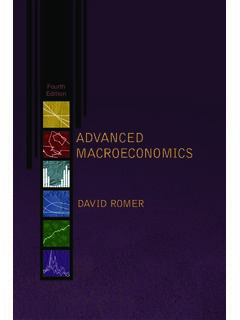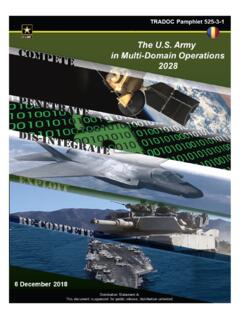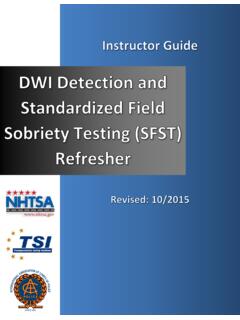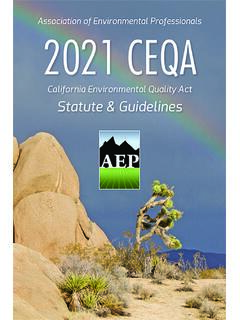Transcription of This page intentionally left blank. - US EPA
1 This page intentionally left blank. Background The Office of Wastewater Management of the Environmental Protection Agency's (EPA's). Office of Water prepared this guidance document to assist municipalities that own or operate publicly owned treatment works (POTWs) in developing and implementing local pretreatment programs. Section 402(b) of the Clean Water Act (CWA) provides for EPA to authorize a State to administer its own National Pollutant Discharge Elimination System (NPDES) permit program. In order to be authorized, a State program must include adequate authority to issue permits that ensure compliance with the CWA including section 307(b) pretreatment standards. The program must ensure that permits issued to POTWs include a program to assure compliance with pretreatment standards by significant sources introducing pollutants subject to such standards to the POTW.
2 [Section 402(b)(8), 33 . 1342(b)(8)]. This guidance will assist POTWs in their efforts to meet their requirement to develop pretreatment programs. Disclaimer The discussion in this document is intended solely as guidance. This guidance is not a regulation nor does not it substitute for any requirements under the CWA or EPA's regulations. Thus, it does not impose legally binding requirements on EPA, States, municipalities or the regulated community. The general descriptions provided in this document may not apply to a particular situation based upon the circumstances. This guidance does not confer legal rights or impose legal obligations upon any member of the public. Among other things, the document describes existing requirements with respect to industrial dischargers and POTWs under the CWA and its implementing regulations at 40 CFR 122, 123, 124, and 403 and chapter I, subchapter N.
3 While EPA has made every effort to ensure the accuracy of the discussion in this guidance, a discharger's obligations are determined, in the case of directly discharging POTWs, by the terms of their NPDES permit and EPA's regulations or, in the case of indirect dischargers, by permits or equivalent control mechanisms issued to POTW industrial users or by regulatory requirements. Nothing in this guidance changes any statutory or regulatory requirement. In the event of a conflict between the discussion in this guidance and any permit or regulation, the permit or regulation would be controlling. EPA and local decision makers retain the discretion to adopt approaches on a case-by-case basis that differ from those described in this guidance where appropriate and authorized by EPA regulations, State law, or local ordinances.
4 Mention of trade names or commercial products does not constitute endorsement or recommendation for their use. EPA may decide to revise this guidance without public notice to reflect changes in the Agency's approach to implementing pretreatment standards or to clarify and update text. To determine whether the Agency has revised this guidance and/or to obtain copies, contact the Water Permits Division at (202) 564-9545. You can also determine whether EPA has revised or supplemented the information in this guidance by accessing the document at: This page intentionally left blank. CONTENTS. Acronyms .. xi Glossary .. xv Chapter 1 - Introduction .. 1-1. Purpose of This Manual .. 1-1. Local Limits Statutory Authority.
5 1-1. Local Limits Process .. 1-1. National Pretreatment Standards .. 1-2. Prohibited Discharges .. 1-2. Categorical Standards .. 1-3. Local Limits .. 1-3. The Relationship of Local Limits to Categorical Standards .. 1-3. Organization of the Guidance Manual .. 1-4. Chapter 2 - Overview of Local Limits Development .. 2-1. Local Limits Decision Tree .. 2-1. MAHL Approach to Local Limits Development .. 2-3. Step 1: Determine Pollutants of Concern .. 2-4. Step 2: Collect and Analyze Data .. 2-4. Step 3: Calculate MAHLs for Each POC .. 2-4. Step 4: Designate and Implement Local Limits .. 2-4. Step 5: Addressing Collection System Concerns .. 2-4. Chapter 3 - Determining Pollutants of Concern .. 3 - 1. National POCs.
6 3 - 1. Other Potential POCs .. 3 - 2. NPDES Permit Conditions .. 3 - 2. Water Quality Criteria .. 3 - 3. Sludge Quality Standards .. 3 - 4. Air Quality Standards .. 3 - 4. Resource Protection Criteria .. 3 - 5. Prohibitions on Treatment Plant Interference .. 3 - 5. Prohibitions to Protect the Treatment Works, Collection System, and Workers .. 3 - 5. Scans of POTW Influent, Effluent, and Sludge to Identify Priority Pollutants .. 3 - 6. Evaluations of Industrial and Commercial Discharges .. 3 - 7. Hauled Waste .. 3 - 8. Remediation Site Waste .. 3 - 9. Hazardous Wastes .. 3 - 11. Approval Authority Screening Process to Select Pollutants for Local Limits Sampling Program and Limit Development .. 3 - 11. Summary.
7 3 - 12. Chapter 4 - Data Needed to Develop Local Limits .. 4 - 1. Sampling Locations .. 4 - 2. v At the POTW .. 4 - 2. In the Collection System .. 4 - 3. At Industrial Users .. 4 - 4. Pollutants for Which POTWs Should Sample .. 4 - 4. Sampling Frequencies .. 4 - 5. Sampling Frequencies for Initial Program Development .. 4 - 5. Sampling Frequencies for Ongoing Evaluation .. 4 - 6. Other Sampling Tips .. 4 - 7. Sampling Methods .. 4 - 8. Analytical Methods .. 4 - 10. Information Collection and Maintenance .. 4 - 13. Review and Evaluation of Analytical Results .. 4 - 13. Flow Data .. 4 - 14. Total POTW Flow .. 4 - 14. Sludge Flow to the Digester .. 4 - 14. Sludge Flow to Disposal .. 4 - 14. Flows from Controlled Sources.
8 4 - 15. Flows from Uncontrolled Sources .. 4 - 16. Summary .. 4 - 16. Chapter 5 - Calculation of Maximum Allowable Headworks Loadings .. 5 - 1. Calculation of Removal Efficiencies .. 5 - 1. Removal Efficiency Calculation Methodologies .. 5 - 3. Guidance on Using Different Methodologies .. 5 - 5. Data Quality .. 5 - 6. Applying Removal Efficiencies Reported by Others .. 5 - 7. Calculation of Allowable Headworks Loadings .. 5 - 8. Determination of Suitable Environmental Criteria .. 5 - 8. Effluent-Quality Based AHLs .. 5 - 11. Sludge-Quality Based AHLs .. 5 - 14. Inhibition-Based AHLs .. 5 - 19. Air-Quality Based AHLs .. 5 - 21. AHLs for Conventional and Non-Conventional Pollutants .. 5 - 21. BOD/TSS .. 5 - 22.
9 Ammonia .. 5 - 23. Oil and Grease .. 5 - 23. Determination of the Maximum Allowable Headworks Loading .. 5 - 25. Sample MAHL Calculation .. 5 - 25. Summary .. 5 - 26. Chapter 6 - Designating and Implementing Local Limits .. 6-1. Determination of the Need for New Local Limits .. 6-1. Actual Loadings vs. MAHL .. 6-2. Noncompliance Due to Pass Through or Interference .. 6-2. Establishing Local Limits for Conventional Pollutants .. 6-2. Calculation of Maximum Allowable Industrial Loading .. 6-4. Uncontrolled Sources .. 6-5. Hauled Waste .. 6-6. Safety Factor .. 6-6. Expansion/Growth Allowance .. 6-7. vi Comparison of MAIL Allocation and Implementation Methods .. 6 - 7. Allocation of MAILs Among Controlled Sources.
10 6 - 8. Limit Duration .. 6 - 8. Allocation Approaches .. 6 - 10. Common Sense Assessment .. 6 - 13. Best Management Practices .. 6 - 14. Approval Authority and Adoption Process .. 6 - 15. Public Participation .. 6 - 17. Control Mechanisms .. 6 - 18. Summary .. 6 - 19. Chapter 7 - Local Limits Reviews and Detailed Re-Evaluations .. 7-1. Reviews .. 7-1. Comparison of Current Loadings with MAHLs .. 7-1. Review of Compliance History .. 7-3. Next Steps .. 7-3. Detailed Local Limits Re-Evaluation .. 7-3. Step 1: Assess Current Conditions .. 7-4. Step 2: Collect and Analyze Data .. 7-5. Step 3: Recalculate Existing, or Determine New, MAHLs .. 7-6. Step 4: Implement the Local Limits .. 7-6. Summary .. 7-7. Chapter 8 - Local Limits to Address Concerns About Collection Systems.














![[THIS PAGE IS INTENTIONALLY LEFT BLANK] - dot.state.pa.us](/cache/preview/1/3/b/d/8/d/d/4/thumb-13bd8dd4570a5e462f8fb7a7042a0f0f.jpg)


